Diesen Beitrag auf Deutsch lesen? Bitte scrollen.
After I wrote something about the Japanese supermarkets and bakeries near the Immermannstraße, I’m going to introduce four restaurants of the Japanese district in Düsseldorf today:
- Yaki-the-Emon: Okonomiyaki
- Naniwa: Classical ramen variations
- Takumi 2nd / Tonkotsu Kitchen: Tonkotsu ramen
- Okinii: iPad-Restaurant in all-you-can-eat-style
Yaki-the-Emon
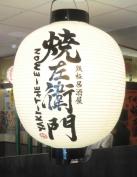 … has the subtitle “Japanese teppan grill & sake bar”, but you can find the real culinary highlights on the lunch menu. Because only at lunch time Yaki-the-Emon offers okonomiyaki. For all, who are not familiar with the name: Okonomiyaki are Japanese potato fritters (without potatoes) made of cabbage, flour, egg, dashi stock (fish stock), sometimes yam and water, which is eaten with different toppings, a special sweet-aromatic sauce and mayonnaise. There exists the Kansai and the Hiroshima version. The difference is in the way of preparation. In Hiroshima you especially add pan-fried noodles. The okonomiyaki also has single layers while the Kansai version mixes all ingredients together.
… has the subtitle “Japanese teppan grill & sake bar”, but you can find the real culinary highlights on the lunch menu. Because only at lunch time Yaki-the-Emon offers okonomiyaki. For all, who are not familiar with the name: Okonomiyaki are Japanese potato fritters (without potatoes) made of cabbage, flour, egg, dashi stock (fish stock), sometimes yam and water, which is eaten with different toppings, a special sweet-aromatic sauce and mayonnaise. There exists the Kansai and the Hiroshima version. The difference is in the way of preparation. In Hiroshima you especially add pan-fried noodles. The okonomiyaki also has single layers while the Kansai version mixes all ingredients together.
Yaki-the-Emon offers the Kansai version which is also more common throughout Japan. As guest you have the choice: With or without pork meat, with kimchi, seafood or maybe natto (fermented soy beans)? With prices between 10,- € (vegetarian) and 20- € (special version with scallops and oysters) you can guess the little upper price range in Düsseldorf – therefore the servings are big and filling. Each okonomiyaki is served with a little salad and a miso soup. For 1,50 € you can jazz up your okonomiyaki with cheese or a soft boiled egg. Additional toppings for upcharge are available as well.
In Japan there are restaurants, that solely sell okonomiyaki in different versions. Often the tables for the guests have a big teppan steel plate integrated, so that the okonomiyaki can sizzle on when it’s served onto the plate or it is made directly at the table. At Yaki-the-Emon the okonomiyaki is served in a little pannikin.
Who doesn’t like the Japanese cabbage pancake, can decide between roasted beef, roasted beef tongue or a vegetable assortment, each dish with rice, miso soup and salad.
Of the four, Yaki-the-Emon is the restaurant with the most Japanese decoration elements, that create a cosy atmosphere. Who is in the mood, can take place on a zaisu (Japanese chair without legs) in the Japanese style section and a Billiken (ビリケン, actually from the USA, but a famous mascot for Osaka) is greeting at the intrance and exit of the restaurant.
- Billiken (ビリケン)
- Japanese style section with zaisu seats ☆ Bereich im japanischen Stil mit Saizu-Sitzplätzen
- a piece of okonomiyaki ☆ ein Stück Okonomiyaki
Naniwa
 … takes you into the world of ramen! That Japanese noodle soup is not only made from noodles, salt and water, can be proved and tested here. Since the restaurant is specialized in ramen dishes (on the other side of the street is a Naniwa sushi store), there are offered different variations of the soup. While restaurants, that sell solely a specific form of ramen, are popular in Japan, in German shops you often have the agony of choice like at Naniwa: Besides the basic types of shio (soup with salt base), shōyu (soup with soy sauce base) and miso (soup with miso paste that means soy beans paste base), there is also a curry, a thai-curry and a tantanmen version (mincemeat, chili oil, sesame paste). You can enjoy your ramen vegetarian, with
… takes you into the world of ramen! That Japanese noodle soup is not only made from noodles, salt and water, can be proved and tested here. Since the restaurant is specialized in ramen dishes (on the other side of the street is a Naniwa sushi store), there are offered different variations of the soup. While restaurants, that sell solely a specific form of ramen, are popular in Japan, in German shops you often have the agony of choice like at Naniwa: Besides the basic types of shio (soup with salt base), shōyu (soup with soy sauce base) and miso (soup with miso paste that means soy beans paste base), there is also a curry, a thai-curry and a tantanmen version (mincemeat, chili oil, sesame paste). You can enjoy your ramen vegetarian, with 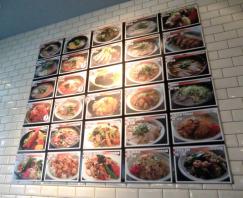 chashu (pork meat cut as thin as bacon), with pork belly, with prawns and squid, with kimchi or wantan dumplings – spicy, not spicy, with garlic or without. Furthermore you can order additional toppings like soft boiled eggs, corn or seaweed. The dishes cost averaging 9,- € to 10,- €, what is quite adequate for Düsseldorf. Who has no stomach for soup, can resort to low-key rice or noodle dishes, what would be a pitty. Although the soup was even better in my memory, I was still convinced by the taste. Especially I want to notice the tasty firm to bite noodles!
chashu (pork meat cut as thin as bacon), with pork belly, with prawns and squid, with kimchi or wantan dumplings – spicy, not spicy, with garlic or without. Furthermore you can order additional toppings like soft boiled eggs, corn or seaweed. The dishes cost averaging 9,- € to 10,- €, what is quite adequate for Düsseldorf. Who has no stomach for soup, can resort to low-key rice or noodle dishes, what would be a pitty. Although the soup was even better in my memory, I was still convinced by the taste. Especially I want to notice the tasty firm to bite noodles!
It is recommended, not to go to Naniwa in the main lunch or dinner time or respectively in good time in advance or to have a bit waiting time in mind. Like most of the restaurants in the Japanese district of Düsseldorf, Naniwa is well-frequented and not uncommonly there is a long queue in front of the entrance, so that there is a specially built bench, which is also customary for restaurants in Japan. The interior of Naniwa has a rather minimalistic design, but well, food matters!
By the way “Naniwa” is the former name of the town Osaka and also a town ward of Osaka today, though the old town’s name as well as the ward’s name are each written with different kanji while the restaurant name is hold in hiragana.
- Chashu Miso Ramen with corn ☆ Chashu Miso Ramen mit Mais
- Tokusei Shōyu Ramen with double chashu (pork meat) ☆ Tokusei Shōyu Ramen mit doppelt Chashu (Schweinefleisch)
- Chashu Curry Ramen
Takumi 2nd / Tonkotsu Kitchen
 … could be a perfect insiders’ tip – if Takumi wasn’t already a very successful restaurants with stores in Düsseldorf, Munich and Berlin. For me as a big fan of ramen the visit of the restaurant was a totally great experience! The speciality of this Takumi store is tonkotsu ramen, that means ramen noodle soup with pork meat taste. The broth is made of pork bones and pork head that has been cooked for several hours and therefore is especially smooth with a thicker, cream-coloured texture. Though the restaurant also offers tasty looking shōyu and miso versions, I would definitely decide for a standard tonkotsu ramen for 8,80 € or the RED special (spicy, 10,80 €) or the BLACK special (with much garlic, 10,80 €). Tantanmen (with spicy miso paste, mincemeat, chili oil and sesame paste) even looks better and more authentic than at Naniwa, but unfortunately you cannot order two soups at the same time. 😦 Eggs, cod roe, garlic, bamboo sprouts, green onions and pork belly can be ordered as toppings as well for an upcharge. An extra portion of noodles or rice as a side dish is also available.
… could be a perfect insiders’ tip – if Takumi wasn’t already a very successful restaurants with stores in Düsseldorf, Munich and Berlin. For me as a big fan of ramen the visit of the restaurant was a totally great experience! The speciality of this Takumi store is tonkotsu ramen, that means ramen noodle soup with pork meat taste. The broth is made of pork bones and pork head that has been cooked for several hours and therefore is especially smooth with a thicker, cream-coloured texture. Though the restaurant also offers tasty looking shōyu and miso versions, I would definitely decide for a standard tonkotsu ramen for 8,80 € or the RED special (spicy, 10,80 €) or the BLACK special (with much garlic, 10,80 €). Tantanmen (with spicy miso paste, mincemeat, chili oil and sesame paste) even looks better and more authentic than at Naniwa, but unfortunately you cannot order two soups at the same time. 😦 Eggs, cod roe, garlic, bamboo sprouts, green onions and pork belly can be ordered as toppings as well for an upcharge. An extra portion of noodles or rice as a side dish is also available.
It is very recommendable to decide for gyōza (dumplings filled with meat and vegetables), that are offered in unique variations here like coated with miso paste and sesame or with cheese and algae. Takumi 2nd also offers Japanese curry dishes with rice as a menu for noodle haters and who still has a bit empty space in the stomach, can order side dishes like takoyaki (dough balls with octopus filling), deep-fried chicken pieces or edamame (salted green soybeans).
Also for Takumi 2nd there is the rule: Life punishes those who delay. That means avoid the main lunch and dinner times, be there in time or approve waiting times. The restaurant has less seats, that is also authentic Japanese (unfortunately). 😉
- tonkotsu ramen with bamboo sprouts ☆ Tonkotsu Ramen mit Bambussprossen
- Tonkotsu Ramen RED special (with different kinds of chili)
Okinii
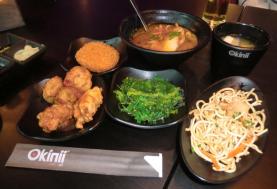 … means “thank you” in Kansai dialect and is an iPad restaurant in all-you-can-eat-style, which already has stores in Düsseldorf, Wiesbaden, Saarbrücken and Cologne and another one opening in Essen soon.
… means “thank you” in Kansai dialect and is an iPad restaurant in all-you-can-eat-style, which already has stores in Düsseldorf, Wiesbaden, Saarbrücken and Cologne and another one opening in Essen soon.
Since I experienced Okinii as extremely unfrequented as well as chock-full, I recommend to reserve a table for special occasions or during happenings like the Japan Day. The new store at Düsseldorf-Medienhafen is still less crowded than the one at Immermannstraße. Both stores are amazing spacious and have a rather modern lounge atmosphere, though I would describe the main store in the Immermannstraße as a bit more Japanese and the other store as a bit more Western-like or also more futuristic. However there is no difference in the menu.
 The all-you-can-eat-concept for a fixed price (mostly time-limited) seems to be more common in Japan than over here in my opinion. At Okinii – and also this exists in Japan – you order by electronical menu on the iPad. Therefore you’ve got 2,5 hours (and if you’re not used to technique, the friendly staff will guide you through or help you whenever you’ve got a problem). At lunch time you can order max. 8 different dishes per person for one order handling, in the evening 5 ones. Although there is a number of extra treats in the evening, I would definitely recommend the lunch packet for 15,90 € per person (the dinner price is 26,90 €). When all ordered dishes are eaten, you can go for the next order. Okinii has a cunning concept against prodigals: Who ordered too much and cannot finish the dishes, has to pay a penal price for each dish. 😛
The all-you-can-eat-concept for a fixed price (mostly time-limited) seems to be more common in Japan than over here in my opinion. At Okinii – and also this exists in Japan – you order by electronical menu on the iPad. Therefore you’ve got 2,5 hours (and if you’re not used to technique, the friendly staff will guide you through or help you whenever you’ve got a problem). At lunch time you can order max. 8 different dishes per person for one order handling, in the evening 5 ones. Although there is a number of extra treats in the evening, I would definitely recommend the lunch packet for 15,90 € per person (the dinner price is 26,90 €). When all ordered dishes are eaten, you can go for the next order. Okinii has a cunning concept against prodigals: Who ordered too much and cannot finish the dishes, has to pay a penal price for each dish. 😛
 On the menu there are 20 kinds of sushi, different salads and soups as well as vegetarian and meat-containing delicacies. All dishes are small like Spanish tapas, so that you can try to your heart’s content. Vegetable tempura (deep-fried vegetables), salmon from the teppan grill, pan-fried noodles, tofu with teriyaki sauce, sepia-seaweed salad or a miso soup? Or better crispy roasted duck or a vegetable croquette?
On the menu there are 20 kinds of sushi, different salads and soups as well as vegetarian and meat-containing delicacies. All dishes are small like Spanish tapas, so that you can try to your heart’s content. Vegetable tempura (deep-fried vegetables), salmon from the teppan grill, pan-fried noodles, tofu with teriyaki sauce, sepia-seaweed salad or a miso soup? Or better crispy roasted duck or a vegetable croquette?
Maybe everything in a row! 🙂
But eat up everything! 😉
For dessert you can get icecream on the house, including sesame, black sesame and mango.
Who’s still hungry?
 (This post is also part of the monthly blogging event Our Growing Edge, run by Genie from Bunny Eats Design. It is a link list of blog posts to similar topics and aims to connect food lovers & food bloggers and inspire all of us to try new things. This month is hosted by Sophie at Cooking Trips and the theme is Travel.)
(This post is also part of the monthly blogging event Our Growing Edge, run by Genie from Bunny Eats Design. It is a link list of blog posts to similar topics and aims to connect food lovers & food bloggers and inspire all of us to try new things. This month is hosted by Sophie at Cooking Trips and the theme is Travel.)
Das japanische Viertel in Düsseldorf: Okonomiyaki, Ramen & Co
Nachdem ich im vorherigen Post etwas über die japanischen Supermärkte und Bäckereien in der Nähe der Immermannstraße geschrieben habe, stelle ich heute vier Restaurants in Düsseldorfs japanischem Viertel vor:
- Yaki-the-Emon: Okonomiyaki
- Naniwa: Klassische Ramen-Variationen
- Takumi 2nd / Tonkotsu Kitchen: Tonkotsu Ramen
- Okinii: iPad-Restaurant im All-you-can-eat-Stil
Yaki-the-Emon
… trägt den Untertitel “Japanese Teppan-Grill & Sake Bar”, doch die wahren kulinarischen Highlights lassen sich auf der Mittagskarte finden. Nur zur Mittagszeit bietet Yaki-the-Emon nämlich Okonomiyaki an. Für alle, denen der Name nicht geläufig ist: Okonomiyaki sind mit verschiedenen Zutaten belegte japanische Puffer aus Kohl, Mehl, Ei, Dashi-Brühe (Fischbrühe), manchmal Yamswurzel und Wasser, die mit einer speziellen, süßlich-würzigen Sauce und Mayonnaise verzehrt werden. Es gibt sie in der Kansai- und der Hiroshima-Variante. Der Unterschied besteht in der Zubereitungsart. In Hiroshima werden vor allem noch gebratene Nudeln verwendet. Das Okonomiyaki hat außerdem einzelne Schichten, während bei der Kansai-Variante die Zutaten miteinander vermischt werden.
Yaki-the-Emon bietet die in Japan verbreitetere Kansai-Variante an. Als Gast hat man die Wahl: Mit oder ohne Schweinefleisch, mit Kimchi, Meeresfrüchten oder vielleicht Natto (fermentierte Sojabohnen)? Mit Preisen von 10,-€ (vegetarisch) bis 20,- € (Spezial-Version mit Jakobsmuscheln und Austern) zeigt sich Düsseldorfs gehobenes Preis-Niveau – dafür sind die Portionen aber auch groß und sättigend. Jedes Okonomiyaki wird mit einem kleinen Salat und einer Miso-Suppe serviert. Für 1,50 € kann man sein Okonomiyaki mit Käse oder einem weich gekochten Ei ergänzen. Weitere Zutaten sind gegen Aufpreis ebenfalls möglich.
In Japan gibt es Restaurants, die ausschließlich Okonomiyaki in verschiedenen Versionen anbieten. Oft haben die Tische der Gäste eine große Teppan-Platte eingebaut, sodass das Okonomiyaki auf der Platte weiterbrutzeln kann, wenn es serviert wird oder auch direkt dort zubereitet werden kann. Bei Yaki-the-Emon wird das Okonomiyaki in einem Pfännchen serviert.
Wer den japanischen Kohl-Pfannkuchen nicht mag, hat die Wahl zwischen gebratenem Rindfleisch, gebratener Rinderzunge oder einer Gemüse-Komposition, jeweils mit Reis, Misosuppe und Salat.
Von den Vieren ist Yaki-the-Emon das Restaurant mit den meisten japanischen Deko-Elementen, die eine gemütliche Atmosphäre gestalten. Wer möchte, kann im japanischen Sitzbereich auch auf einem Zaisu (japanischer Stuhl ohne Beine) Platz nehmen und ein Billiken (ビ リケン, eigentlich aus den USA, aber ein bekanntes Maskottchen für Osaka) grüßt am Ein- und Ausgang des Restaraunts.
Naniwa
… entführt einen in die Ramen-Welt! Dass japanische Nudelsuppe nicht nur aus Nudeln, Salz und Wasser besteht, kann hier erprobt und getestet werden. Da sich das Restaurant auf Ramen-Gerichte spezialisiert hat (gegenüber ist auch eine Naniwa Sushi-Filiale), werden diese in den unterschiedlichsten Variationen angeboten. Während es in Japan oft Restaurants einer bestimmten Ramen-Sorte gibt, hat man in deutschen Läden meist wie bei Naniwa die Qual der Wahl: Neben den Grundtypen Shio (Suppe auf Salzbasis), Shōyu (Suppe auf Sojasaucenbasis) und Miso (Suppe auf Miso(Sojabohnen)pastebasis gibt es auch eine Curry-, eine Thai-Curry- und eine Tantanmen-Variante (Hackfleisch, Chiliöl, Sesampaste). Man kann seine Ramen vegetarisch, mit Chashu (schinkendünn geschnittenes Schweinefleisch), mit Schweinebauch, mit Krabben und Tintenfisch, mit Kimchi oder Wantan-Teigtaschen genießen – scharf, nicht scharf, mit Knoblauch oder ohne. Außerdem lassen sich zusätzliche Toppings wie weichgekochte Eier, Mais oder Seetang dazubestellen. Die Gerichte kosten durchschnittlich 9,- bis 10,- €, was in Düsseldorf durchaus angemessen ist. Wem nicht nach Suppe zumute ist, der kann auf einfach gehaltene Reis- oder Nudelgerichte zurückgreifen, aber das wäre schade. Obwohl ich die Suppe tatsächlich noch besser in Erinnerung hatte, war ich immer noch überzeugt vom Geschmack. Besonders hervorheben möchte ich aber vor allem die leckeren bissfesten Nudeln!
Es empfiehlt sich, nicht zur Hauptessenszeit bzw. rechtzeitig vorher im Naniwa zu sein oder etwas Wartezeit mit einzuplanen. Wie die meisten der Restaurants in Düsseldorfs japanischem Viertel ist das Naniwa sehr gut besucht und nicht selten bildet sich eine lange Schlange vor dem Eingang, sodass dort eigens eine Bank eingerichtet wurde, was bei Restaurants in Japan durchaus auch üblich ist. Die Inneneinrichtung des Naniwa ist eher minimalistisch gehalten, aber es kommt ja schließlich aufs Essen an!
„Naniwa“ ist übrigens der ehemalige Name der Stadt Osaka sowie ein heutiger Stadtbezirk Osakas, wobei sich der alte Stadtname und der Stadtbezirksname jeweils mit anderen Kanji schreiben, während der Restaurant-Name in Hiragana gehalten ist.
Takumi 2nd / Tonkotsu Kitchen
… könnte einen perfekten Geheimtipp abgeben – wäre Takumi nicht ohnehin schon ein sehr erfolgreiches Restaurant mit Filialen in Düsseldorf, München und Berlin. Für mich als großer Ramen-Fan war der Besuch des Restaurants ein voller Erfolg! Die Spezialität dieses Takumi-Ablegers ist Tonkotsu Ramen, also Ramen-Nudelsuppe mit Schweinefleischgeschmack. Die Brühe wird aus Schweineknochen und Schweinekopf mehrere Stunden lang gekocht, ist dadurch besonders sämig und erhält eine etwas dickere, cremefarbene Textur. Obwohl das Restaurant auch lecker aussehende Shōyu- und Miso-Versionen anbietet, würde ich hier unbedingt das Standard-Tonkotsu Ramen für 8,80 € nehmen oder aber das RED-Special (scharf, 10,80 €) oder das BLACK-Special (mit viel Knoblauch, 10,80 €). Tantanmen (mit scharfer Misopaste, Hackfleich, Chiliöl und Sesampaste) sieht hier sogar noch besser und authentischer aus als im Naniwa, aber leider kann man nicht zwei Suppen gleichzeitig bestellen. 😦 Eier, Dorsch-Rogen, Knoblauch, Bambussprossen, Lauchzwiebeln und Schweinebauch lassen sich außerdem gegen Aufpreis als Toppings bestellen. Ebenso ist eine Extra-Portion Nudeln erhältlich oder Reis als Beilage. Sehr empfehlenswert sind auch die Gyōza (mit Fleisch und Gemüse gefüllte Teigtaschen), die hier in einzigartigen Varianten angeboten werden, z.B. mit Misopaste und Sesam bestrichen oder mit Käse und Algen. Nudelhassern bietet Takumi 2nd japanische Curry-Gerichte mit Reis als Menü an und wer immer noch Platz im Magen hat, kann Beilagen wie Takoyaki (Teigbällchen mit Oktopusfüllung), frittierte Hähnchenstücke oder Edamame (gesalzene grüne Sojabohnen) bestellen.
Auch bei Takumi 2nd gilt: Wer zu spät kommt, den bestraft das Leben. Also Hauptessenszeiten meiden, rechtzeitig da sein oder Wartezeiten in Kauf nehmen. Das Restaurant hat nicht viele Sitzplätze, was (leider) auch authentisch japanisch ist. 😉
Okinii
… bedeutet „Danke“ im Kansai-Dialekt und ist ein iPad-Restaurant im All-you-can-eat-Stil, welches bereits Filialen in Düsseldorf, Wiesbaden, Saarbrücken und Köln hat und demnächst in Essen seine Türen öffnet.
Da ich Okinii sowohl spärlich besucht, als auch rappelvoll kennengelernt habe, empfehle ich, zu wichtigen Anlässen oder bei Ereignissen wie dem Japan-Tag zu reservieren. Die neue Filiale am Medienhafen in Düsseldorf ist noch geringer besucht als die in der Immermannstraße. Beide Läden sind unglaublich groß und haben eine eher moderne Lounge-Atmosphäre, wobei ich die Hauptfiliale in der Immermannstraße als etwas japanischer und die andere Filiale als etwas westlicher oder auch futuristischer bezeichnen würde. Einen Unterschied bei der Essensauswahl gibt es nicht.
Das All-you-can-eat-Prinzip für einen Festpreis (meistens zeitlich begrenzt) scheint in Japan meiner Meinung nach weiter verbreitet zu sein, als hierzulande. Im Okinii bestellt man – und auch das gibt es in Japan – per elektronischer Speisekarte auf dem iPad. Dazu hat man 2,5 Stunden Zeit (und wenn man sich mit der Technik nicht auskennt, wird einem die freundliche Bedienung alles erklären oder aushelfen, wann immer man ein Problem hat). Zur Mittagszeit können pro Bestellrunde max. 8 verschiedene Gerichte pro Person bestellt werden, abends 5. Obwohl es abends eine Reihe von Extra-Leckerbissen gibt, würde ich unbedingt das Lunch-Paket für 15,90 € pro Person empfehlen (der Dinner-Preis ist 26,90 €). Sobald alle bestellten Gerichte verzehrt sind, darf die nächste Bestellrunde erfolgen. Okinii geht bei diesem Prinzip raffiniert gegen Verschwender vor: Wer zuviel bestellt hat und die Gerichte nicht aufisst, muss pro Teller einen Strafpreis zahlen. 😛
Auf der Speisekarte stehen 20 verschiedene Sushi-Arten, verschiedene Salate und Suppen sowie vegetarische und fleischhaltige Köstlichkeiten. Alle Gerichte sind klein wie spanische Tapas, sodass man nach Herzenslust probieren kann. Gemüse-Tempura (frittiertes Gemüse), Lachs vom Teppangrill, gebratene Nudeln, Tofu mit Teriyaki-Sauce, Sepia-Seetangsalat oder eine Misosuppe? Oder doch lieber kross gebratene Ente oder eine Gemüse-Krokette?
Vielleicht auch alles nacheinander! 🙂
Aber schön aufessen! 😉
Zum Nachtisch gibt es Eis auf Kosten des Hauses, darunter Sesam hell, Sesam schwarz und Mango.
Wer hat noch Hunger?
(Dieser Post ist auch Teil des monatlichen Blog-Events Our Growing Edge, ins Leben gerufen durch Genie von Bunny Eats Design. Es ist eine Link-Sammlung von Blog-Beiträgen zu ähnlichen Themen and zielt darauf ab, Foodies und Food Bloggers zusammenzuführen und uns alle zu inspirieren, neue Dinge auszuprobieren. Diesen Monat wird das Event bei Sophie auf Cooking Trips veranstaltet und das Thema lautet: Travel.)

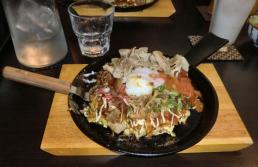
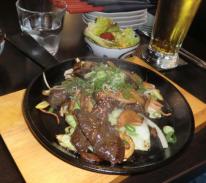



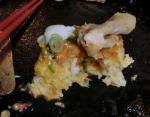
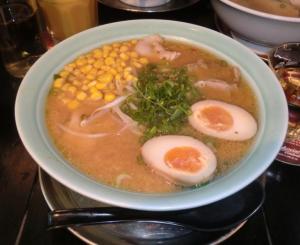
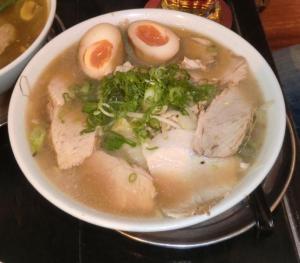
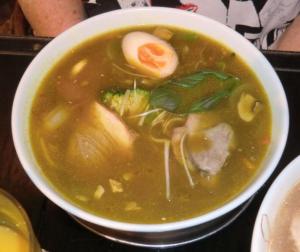

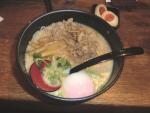
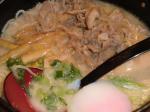
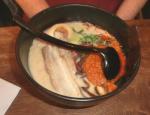
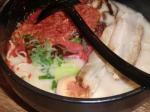

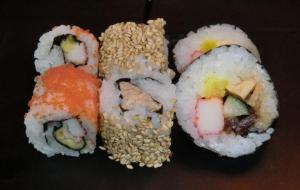

How did I miss this? Japanese food in Germany sounds like the best of two worlds! 🙂
LikeLike
Hahaha, thanks for your comment. But the above restaurants offer very authentic food from Japan. So there’s no mix with German dishes at all. 😛
Anyway, if you like to see more posts about German or Japanese food, you can check out my Categories page in the head menu and scroll down to “Food & Drinks” to find food-related posts. ^^
(https://currywurstandkimono.wordpress.com/categories/) 🙂
LikeLiked by 1 person
So interesting there is a Japanese district there. I can’t think of any Japanese districts in my city or country, though we do have clusters of Asian business in certain areas.
This post would make a great addition to Our Growing Edge, a monthly blog link up just for new food adventures. It’s a fun way to share your new food experiences with other foodies. This month’s theme is TRAVEL which includes any recipe or food experience inspired by travel.
More info including how to submit your link here: http://bunnyeatsdesign.com/our-growing-edge/
LikeLike
Hm, in my city there is also no Asian district, but we have several Japanese restaurants in one area and also much food from around the world.
Thanks for inviting me to the link event. I joined it as you can see above. ^^
You are really a food lover, aren’t you?
By the way, I also wrote about Japanese restaurants in Paris:
🙂
LikeLike
Pingback: TRAVEL Theme of Our Growing Edge, July 2016 Round-Up. – COOKING TRIPS
Pingback: Japan Day in Düsseldorf 2016 ☆ Japan-Tag in Düsseldorf 2016 | Currywurst & Kimono
Pingback: The Japanese district in Düsseldorf: supermarkets & bakeries ☆ Das japanische Viertel in Düsseldorf: Supermärkte & Bäckereien | Currywurst & Kimono
Pingback: Japanisches Kochrezept: Okonomiyaki ☆ Japanese Cooking Recipe: Okonomiyaki | Currywurst & Kimono